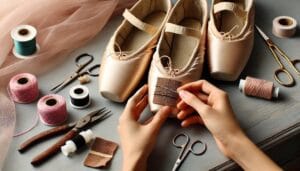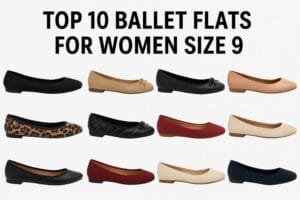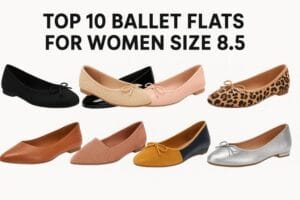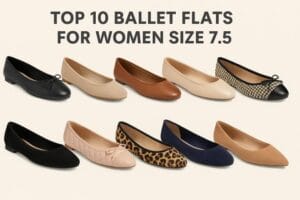Can You Wear Ballet Flats in the Winter? (12 Questions Answered)
- Published on -
- By - Sophia Webster
- Reviewed by - Tory Burch
- Reading Time - 11 Minutes
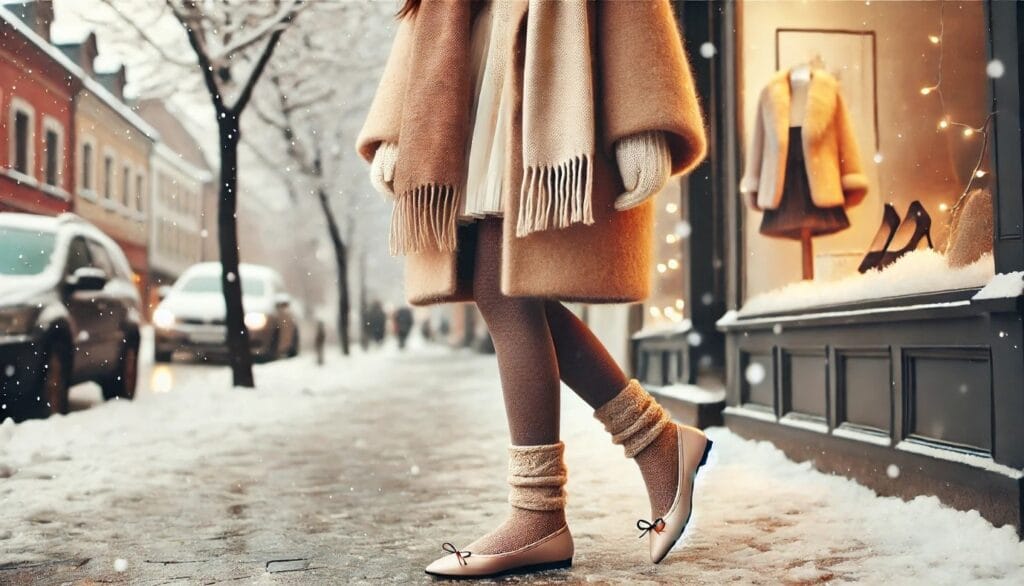
Share this Post
Recent Posts
About Author
Sophia Webster
In this article, we explore whether ballet flats are a practical option for winter and how to wear them without compromising warmth or safety.
Q1. Can You Wear Ballet Flats in Winter?
Ballet flats can be worn every day and are comfortable. When the temperatures drop, you may wonder if the delicate shoes will be able to withstand the winter chill. You can enjoy your ballet flats in style and warmth with a few simple tips.
Use Warm Insoles
Tip: Add a layer to your flats by using thermal or cushioned insoles.
Solution: Insoles are not only comfortable, but they also warm up your feet and make your flats suitable for colder days.
Pair with Thick Socks
Tip: Wear stylish thick socks with ballet flats in winter.
Solution: This simple add-on provides extra warmth, and can also give your outfit a stylish, layered appearance.
Waterproof Your Shoes
Tip: Spray a waterproofing spray for delicate shoes.
Solution: It protects your ballet flats against snow and slush. This will ensure they stay in good condition even during wet winter weather.
Opt for Indoor-Outdoor Transition
Tip: Save your ballet flats to days when the weather is milder or for indoor events.
Solution: You can maintain the quality of your shoes while enjoying their elegance by limiting exposure to harsh conditions.
Q2. How can you keep your feet warm in ballet flats during the winter?
Ballet flats have a timeless design, but the minimal design may make your feet chilly during winter. You can have both style and comfort with a few clever tweaks. Here are some tips to keep your feet toasty when wearing ballet flats during colder weather.
- Thermal Insoles
The thermal insoles will provide an additional layer of insulation for your flats. Choose heat-retaining insoles that are slim and won’t alter the fit of your shoe. These insoles will keep your feet warm all day.
- Use Sock Liners
They are thin, lightweight socks that provide warmth without altering the look of your ballet shoes. These socks create a barrier to protect your feet from the cold. They make your ballet flats more comfortable in winter.
- Consider Heated Insoles and Foot Warmers
Consider investing in heated insoles and foot warmers for those extra cold days. These solutions are modern and discreet. They can easily be inserted into flats for consistent warmth.
- Select Flats With A Slightly Lined Inside
Consider styles that have a lined interior when shopping for ballet flats during the winter. Soft linings can provide additional comfort and warmth while maintaining a stylish look.
Q3. Which ballet flats do you recommend for winter or cold weather?
Comfort and style are essential for winter, even in ballet flats. Ballet flats are not designed to withstand freezing temperatures. However, with a few adaptations, they can be a good choice for the winter months. Here are a few top tips and options to help you stay warm and stylish this winter.
Flats that are lined or insulated
Choose ballet flats lined with soft materials such as fleece or shearling.
Tip: The added layers of the flat design provide warmth.
Waterproof Materials
Select flats that are made of leather or synthetic materials resistant to moisture.
Tip: You can protect your shoes by using a waterproof treatment or coating. This will keep your feet dry during rainy and snowy weather.
Rubber or Textured Soles
Flats with thick rubber soles provide better traction than traditional thin soles on icy surfaces.
Tip: Choose designs that have extra grip patterns in order to reduce the chance of slipping on wet or icy sidewalks.
High-top Ballet Flats
Consider ballet flats that have a higher cut at the ankle to provide extra warmth and protection.
Tip: This style offers extra coverage without sacrificing the elegance of ballet flats.
Flats with thick socks or insoles
If your flats don’t come with a built-in winterization, you can easily transform them by adding thick socks, or insoles that are cushioned.
Tip: Choose moisture-wicking socks to keep your feet warm in cold weather.
Q4. Is it possible to wear ballet flats and tights or socks in winter?
Ballet flats can be worn all year round, including in the winter. Pairing them with tights or socks can help you stay warm without sacrificing your style. Here are some solutions and tips to help you stay warm while looking stylish:
- Select the Right Tights or Socks
Choose socks made from luxurious materials such as cashmere and wool for warmth and elegance. Choose opaque tights in neutral colors or complementary shades. These options create a polished, smooth look for your ballet flats.
- You can embrace a monochrome or coordinated look
Match the color of your socks and tights to your flats. Monochrome or subtle contrasts can make your outfit look stylish and intentional.
- Take into consideration the length and fit
To keep your flats in focus, choose socks that are ankle-length or low-cut. Wearing tights with the right-length skirts or dresses will avoid clutter. Fitted accessories can create a sleek silhouette.
- Layer Thoughtfully
Combine ballet flats and socks or tights to create a winter ensemble. Think of chic skirts and tailored pants as well as stylish outerwear. You will not only look more stylish but you will also stay warm in the winter months.
Q5. Is it safe to wear ballet flats in icy or snowy conditions?
Ballet flats can be a great choice for everyday wear. However, winter weather poses unique challenges. Snow and ice, while offering style and comfort, can also pose risks such as slips, cold toes, and water damage. You can use these tips to decide whether ballet flats will work in icy conditions.
Traction and Grip
Tip: Ballet shoes often have shallow treads which can cause poor traction when ice is present.
Solution: Use non-slip grips or attachable ice grits to provide extra traction. These accessories will help to reduce the chance of slipping and maintain the aesthetics of the flat.
Insulation and warmth
Tip: Ballet flats that are designed for cold weather will leave your feet exposed.
Solution: Wear thermal inserts or pair flats with socks that wick away moisture. These add-ons will provide extra insulation while maintaining the look of your ballet flats.
Water Resistance
Tip: Slush and snow can seep in to your shoes and cause discomfort over time.
Solution: Spray a waterproof spray on your flats prior to going out in snowy weather. This layer repels water and reduces the impact of slushy conditions.
Q6. How do you waterproof ballet shoes for winter?
Ballet flats can look stylish even in the winter. However, they are susceptible to water damage, especially during the colder seasons. The waterproofing of your flats will not only prolong their life, but also preserve their appearance. Here are some tips and solutions for keeping your ballet flats protected and dry.
Cleaning your flats thoroughly
Tip: Make sure your shoes are clean before applying any waterproofing treatment.
Solution: Use a mild soapy solution to remove any stains and gently brush dirt off with a soft brush or cloth. Allow them to dry completely so as not to trap moisture under the treatment.
Select the Right Waterproofing spray
Tip: Buy a waterproofing spray that is designed for the material of your apartment, whether it be leather, suede or fabric.
Solution: Spray evenly while holding the bottle at a distance of 6 inches. This will create a barrier that is resistant to water, while still allowing the material to breathe.
Use a Leather Conditioner on Leather Flats
Tip: Leather dries out in the winter. Conditioning is important.
Solution: Apply leather conditioner to the leather before waterproofing. This keeps the leather soft, prevents it from cracking and helps the waterproofing spray to adhere better.
Use a sealant to add extra protection
Tip: To increase the durability of your flat, use a sealant that is suitable for its material.
Solution: After the waterproofing spray dries, seal the surface with a thin coat of sealant. This is especially important for flats which are often exposed to harsh winter weather conditions.
Allow them to heal completely
Tip: It is important to be patient after applying waterproofing treatments.
Solution: Let your ballet flats cure for 24 hours or more in a well-ventilated, dry area. The waterproofing product will then fully adhere to the material, providing maximum protection.
Q7. What are some outfits that go well with ballet shoes in the cold?
Ballet flats can be dressed up for cooler weather. You can look stylish, comfortable and appropriate for the season with the right outfits. Here are a few tips on how to pair ballet flats with winter outfits.
Pair with Leggings or Skinny Jeans
Tip: Leggings or skinny jeans create a sleek look that compliments ballet flats’ delicate design.
Solution: Tuck a warm sweater into a fitted jacket for a casual yet polished winter look.
Layer over Tights
Tip: By layering tights underneath skirts and dresses, you can not only keep warm but also enhance your look.
Solution: Wear a midi-skirt with opaque tights, a long cardigan and an opaque hat to achieve a balance between comfort and style.
Wear with a Tailored Coat
Tip: Ballet flats and a tailored coat are a great combination. The ballet flats add softness to the coat, while adding structure.
Solution: Select a classic peacoat or trench coat to keep you outfit refined and winter ready.
Combine with Sweater Dresses
Tip: Sweater dresses look great with ballet flats and are ideal for the cold weather.
Solution: Add tights to your outfit and pair them with your favorite flats.
Accessorize your look with scarves and hats
Tip: Winter accessories such as scarves, hats and gloves not only keep your warm, but they also add visual interest.
Solution: Choose a scarf with a pattern or a beret that is stylish to add personality to a simple outfit paired with ballet flats.
Q8. Is there a ballet flat with insulated or lined soles for winter?
Ballet flats have a timeless appeal, and you can now enjoy them in cold weather. Modern designs come with insulated or lined options that keep your feet warm and comfortable without sacrificing style or comfort. Consider these tips and solutions when selecting winter-friendly ballet flats.
Search for Insulated Materials
Tip: Look for flats with insulation features, such as thermal linings and padded footbeds.
Solution: This feature helps retain heat and provides extra comfort during the colder months.
Warm Linings Available
Tip: Consider using fleece, shearling or other warm lining materials.
Solution: Soft, warm linings not only provide warmth but also improve comfort.
Prioritize quality construction
Tip: Choose flats made by reputable brands that are known for their durability and winter-specific designs.
Solution: By investing in quality, you can ensure that your flats will maintain their insulation properties over multiple winters.
Consider Waterproof or water-resistant features
Tip: Look out for designs with waterproof or water-resistant treatment.
Solution: These features will protect your feet from moisture and the inside lining, making these shoes ideal for rainy or snowy days.
Q9. Can I wear ballet flats and leggings together?
Leggings make a great wardrobe staple. Pairing them with ballet flats creates a stylish, comfortable look. To pull off this look with style, you’ll need to follow a few tips. Here are some tips and solutions that will help you to rock this trend with confidence.
Select the Right Leggings
Tip: Choose leggings that have a structured fit, and are longer in length. This will balance your silhouette.
Solution: Solid-colored leggings of high quality work well with ballet flats. These leggings provide a smooth canvas for the shoes, while maintaining a polished look.
Choose Complementary Ballet Flats
Tip: color and style of your leggings.
Solution: Ballet flats in neutral colors, like black, nude or pastel tones are versatile. To maintain balance, choose flats that are simple and neutral-colored if your leggings have a bold pattern or color.
Add a layer for visual interest
Tip: Add an extra layer, such as a tunic sweater or long sleeve shirt to create a stylish and layered look.
Solution: A cropped sweater or tunic that fits well can help break up the monotony created by leggings and shoes. This will add depth to your outfit, and give it a more cohesive look. It is perfect for semi-formal and casual occasions.
Remember the proportions
Tip: Balance the proportions of your outfit by using fitted and loose pieces.
Solution: Pair your form-fitting leggings with a looser jacket or top. This will not only give you a more flattering look, but it will also keep the focus on your leggings and ballet flats.
Q10. Is it possible to wear ballet flats outdoors?
Ballet flats have been a popular choice for decades, thanks to their comfort and simplicity. When it comes to wearing them outside, there are a few things you should consider. This will help keep you both stylish and comfortable. Here are some quick solutions and tips for wearing ballet flats outdoors:
Take into consideration the weather and terrain
Tip: Do not wear ballet flats when it is raining or on surfaces that are slippery.
Solution: When the weather forecast calls for rain, choose waterproof flats. Alternate with another shoe style to avoid discomfort and damage.
Style and Occasion are Important
Tip: Ballet Flats are suitable for casual occasions, office days, and social events.
Solution: Wear them with dresses, jeans, skirts or skirts for a relaxed, chic look. Choose a pair that is refined and embellished or neutral in color for a more formal setting.
Make Yourself Feel Comfortable
Tip: Comfort is the key to stepping out in the sun.
Solution: Check that your ballet flats are comfortable and add cushioned insoles to them if you intend on walking long distances.
They look new with regular maintenance
Tip: Wearing outdoor clothing can cause scuffs, dents and wear.
Solution: Use touch-up products and clean and polish your flats on a regular basis to keep them looking stylish and new.
Q11. Which heels should I wear in winter?
It can be difficult to balance style and comfort in winter fashion, especially when it comes with heels. The right heels are essential for chilly temperatures and slippery surfaces. Here are some tips on how to choose the perfect winter heels. You will also find practical advice for remaining stylish and safe.
Chunky Heels are a great option
Tip: Chunky heeled shoes offer more stability and balance than stilettos.
Solution: Choose boots or shoes with a thicker sole that will provide extra support, reducing the risk of slipping in ice and snow.
Choose closed-toe styles
Tip: Closed toe heels will keep your feet warm in winter.
Solution: Choose classic ankle boots or pumps with a closed-toe style. These shoes are not only stylish, but they also protect your toes against the cold.
Consider Heeled Booties
Tip: Booties offer warmth and style in one package.
Solution: Choose booties that have a modest heel, and are made of waterproof material. These booties are perfect to wear with jeans and dresses, while also keeping your feet dry in rainy conditions.
Prioritize slip-resistant soles
Tip: Safety during winter is important, as surfaces can be slippery.
Solution: Choose heels with rubber or textured soles that are designed to grip. This additional traction can help to prevent falls and slips on icy sidewalks.
Fashionable Flats: Try them out!
Tip: The best winter heel is sometimes a stylish compromise.
Solution: Choose heels or wedges that offer the best of both worlds. They combine the elegance and comfort of a heel, while still providing the balance you need for the winter.
Q12. In winter, what do ballerinas wear?
Ballerinas are faced with a unique problem when the cold weather arrives: how to stay warm without compromising on their style and flexibility. Here are some tips and solutions to help dancers prepare for rehearsals or performances in comfort.
Layered Leggings & Tights
Tip: Choose thermal tights or legsgings to provide warmth without bulk.
Solution: Select moisture-wicking fabric to keep muscles warm.
Warm Dancewear Jackets & Wraps
Tip: Wear a fitted, light jacket or wrap to cover your dancewear while warming up.
Solution: Choose outerwear for dancing that is both insulating and flexible.
Insulated dance shoes and slippers
Tip: Keep your feet warm with insulated slippers when you’re not dancing.
Solution: Choose warmer, more supportive shoes for your travels to and from the studio to ensure that you are comfortable.
Cozy Accessories
Tip: Don’t forget accessories such as gloves, headbands or ear warmers.
Solution: Choose materials that are soft and stretchy to keep extremities warm.
Conclusion:
Ballet flats will still be a fashionable and practical option in winter 2025 with the right modifications. You can wear them in cold weather with thermal socks, waterproofing sprays, or insoles. They look great with skinny jeans, tunics leggings, or midi dresses.
Choose flats that have insulated linings such as fleece or shearling, waterproof materials, and slip-resistant bottoms. They are less safe on snow or ice than heels with traction, like wedges or block styles. Select brands offer insulated ballet shoes that provide warmth. Ballerinas can layer thermal dancewear over their flats. Ballet flats can be kept in pristine condition all year round with the right styling and care.


